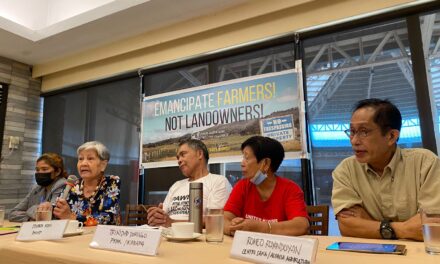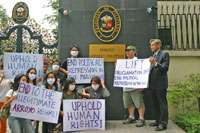by Raphael Baladad
Almost three decades after the Comprehensive Agrarian Reform Program (CARP) had been enacted and two years after the provisions on land acquisition and distribution of CARP with Extension and Reforms (CARPER) expired, the government still has to meet its targets for land redistribution and support services delivery. Although it had its successes, the program has left behind a significant number of farmers longing for land security and sustainable livelihoods.
Alas, the struggle for land continues, even as countless protests, court battles, and dialogues have made even the staunchest peasant leaders grow tired, weary—and literally, old. Some would say that the greatest casualty of the protracted implementation of Agrarian Reform are not those who have fought bravely and died, but the morale of those left to continue with the struggle. The fire within that once brought and kept people together to push for much needed reforms has waned over time.
But there is yet something to look forward to.
The Save Agrarian Reform Alliance (SARA) and Focus on the Global South with several student’s organizations including Ateneans for Agrarian Reform Movement (AFARM), Union of Students for the Advancement of Democracy (USAD), Student Party for Equality and Advancement of Knowledge (PUP-Speak), Alyansa ng mga Mag-aaral para sa Panlipunang Katwiran at Kaunlaran (UP-ALYANSA), and the Bukluran ng mga Progresibong Iskolar (UP Bukluran System) held their second Agrarian Reform Youth Congresses in February 2017 (the first was in 2015). It aimed to empower the youth by helping determine more tangible roles for them in the agrarian social movements. More than just creating a student network that would help promote agrarian reform as a critical issue for the youth, the Congress became a venue for developing mutual relationships among them and with various farmers’ organizations under SARA. The congress outputs were a shot of hope that could revitalize the farmers’ struggle. The young participants identified several activities to support the national advocacies on agrarian reform, namely: (a) community immersions and the documentation of farmers’ struggles; (b) communications and media to heighten public awareness on agrarian reform issues; and (c) research and education on key socio-political and economic issues affecting the development of small-holder agriculture. The ARYC has yet to grow as an independent youth organization, but it is a step towards recognizing and integrating youth roles into larger social movements on land.
Increasing Youth Participation and Involvement
In this age of millennials or today’s youth who find empowerment in social media, there is untapped force. History has shown that successful movements have often had the youth at the vanguard, and this generation, despite stereotypes attributed to them, should not be considered any different. The challenge thus lies in harnessing their energies, not only to support or contribute to, but in the near future lead and sustain, social movements.
Youth involvement is primarily experiential, and largely depends on how they are affected by a given issue. On agrarian reform and rural development, one might expect the sons and daughters of farmers to join protests or mobilizations in support of agrarian reform, but we might not say the same for those who are living far from the sights of struggles. Another factor that can contribute to the lack of ‘affection’ for this issue is the declining appreciation of agriculture and its role in our society and economy. Since farming or farmwork is seen as something synonymous to poverty, youngsters from rural communities would often opt to leave and find jobs in the city.
Convincing the youth to join and commit to such causes has always been a challenge. But to address the age gaps in both the agricultural sector and in the social movements, ARYC was witness to a renewed effort in youth involvement, through the sharing of experiences in the struggle by the peasant leaders, resulting in more awareness of history and present conditions, and by having a space where on their own they were able to make deeper connections, not only form opinions but to strategize as well. It is the connection which social movements foster with the youth that would determine how invested they are in affecting change.
In several occassions, the mere presence of the youth in protests, mobilizations, and in communities have boosted the morale of the farmers. Simply through listening to the stories of farmers, or by just peeking into the living conditions of these farmers, the youth already impart hope. More than just cogs in the social movement’s machinery, the youth create fire that sustains the fervor in a struggle. They are not just second liners but on their own have the ability to inspire, innovate and transcend. More than the need for us to empower the youth, they empower us to carry on.










